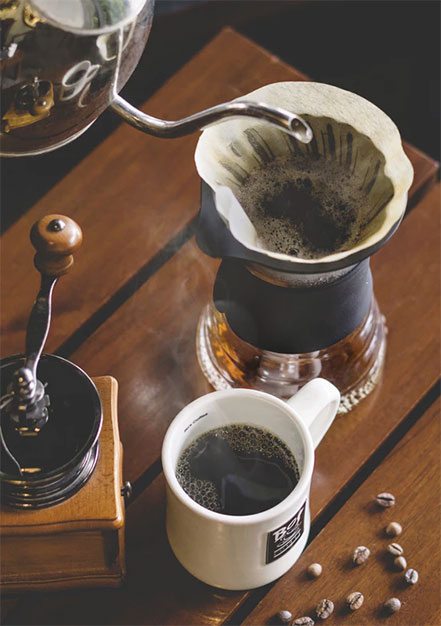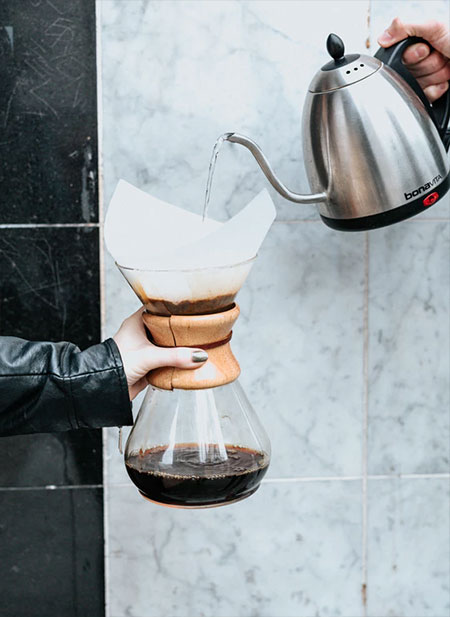Simple and yet complicated : Brewing Coffe with the "pour-over" method

If you are are a coffee lover, you will realize that more and more brewing methods are becoming popular among coffee shops. One of these goes back to the first, basic steps of coffee: the "pour over" brew.
 What is the Pour Over Brew ?
What is the Pour Over Brew ?
In recent years, among the dozens of coffee-based beverages, several different brewing methods have emerged, in addition to the standardized espresso and filter coffee. The different brewing methods either use innovative devices such as AeroPress or change key features of traditional extraction such as Cold Brew, or, finally, return to simplicity and the roots of coffee, such as Pour Over.
As the name of the process suggests, to brew coffee by this method, you have to simply add hot water over freshly ground coffee beans that are placed on a paper filter. The final result of the Pour Over brew is reminiscent of the coffee filter, while its fans claim it to bring out more natural flavor characteristics of coffee than the other brewing methods. But most of all, it has gained the interest of coffee fanatics because, due to its simplicity, it allows (and requires) full and manual control of the factors affecting the cup's final result, such as temperature, grind, extraction time etc.
What's the history of Pour Over ?
The history of Pour Over is as old as the history of coffee, since the process does not differ significantly from the process followed in a mechanical coffee maker, however its rejuvenation within the framework of the Third Wave of Coffee was based mainly on the Japanese coffee culture. The "hand-crafted" extraction, the insistence on detail, the serving that takes the ritual character and the personification of each cup according to the tastes that will be enjoyed are characteristics that surely resemble the Japanese way of life as expressed in many aspects of everyday life of Japan, for example in gastronomy. The Japanese have also developed special Pour Over extractors such as the exquisite aesthetics Harrio V60, which are especially popular with barista's "Third Wave" coffee.
What does one need to use Pour Over Brew?
In terms of technical equipment, the Pour Over method is not particularly demanding since it does not require any particular or expensive equipment. Although Pour Over extractors such as the Harrio V60 or Chemex are particularly beautiful aesthetics, they can be replaced by do-it-your-self constructions as long as there is a way to support a paper coffee filter. What one needs to start working on the Pour Over extraction method is a reliable coffee grinder, a thermometer for temperature control, a small scale, paper filters and a lot of patience and mood for experimentation..
What are the factors that affect the final result during Pour Over ?
Pour Over owes its part of popularity intransforming a daily habit, such as coffee, into a ritual, and on the other hand, in providing full control of the result through a variety of factors. Familiarizing with Pour Over is a demanding process that takes time and experimentation, but it seems this makes it particularly interesting for its fans.

- Coffee Grinding: It is one of the most important factors for the success of coffee, both on its own and in conjunction with other factors, such as temperature and water flow. Buying a quality coffee grinder is the first step for anyone wishing to seriously deal with this brewing method. Coffee with coarser grinding than the right one will display high acidity and weak body, while thinner grinding will result in coffee with intense bitterness and unpleasant taste.
- Water Temperature: Generally, the recommended temperature for coffee extraction by this method is between 90-96 degrees Celsius, with temperature fluctuations giving slightly different results. Experienced baristi use interactions of these factors to achieve the desired effect (eg coarser milling with higher temperature or vice versa).
- Water flow: The Pour Over process is based on pouring hot water over the ground coffee. The rate of water spill (slow, fast, constant or irregular) plays a role, as is normal, in the final result that we will taste.
- Pouring the paper filter and CO2 expulsion: Two of the most common "tricks" for Pour Over are the wetting of the paper filter and the removal of unnecessary CO2 from the ground coffee obtained by the initial wetting of the coffee before the flow of water begins. As simple as these processes are heard, they affect the final taste of the coffee and can be varied as desired.
As it can be seen, the success of our final cup of coffee depends on many factors and requires special experience and familiarity with the brewing process. Several recommend that beginners should write down notes about the steps they follow and the results of each effort to get the desired result, depending on the coffee they use. It's a tedious and painful process that can not fit those who just want to have a cup of coffee to start their day, but on the other hand, it looks ideal for those who treat coffee as a hobby.
Coffee is a truly magical world: either you prefer to enjoy your precious beans as a traditional Italian espresso or you want to experiment with brewing methods like Pour Over, the only thing that is sure is that with so many flavors, aromas and smells, you will never get bored!










